 |
Home |
Catalogs |
Contact Us |
Books on:
Animal RightsBlack History
Clean Energy
Democracy
Eco Design
Eco History
Food and Nutrition
Genetic Engineering
Green Cities
Green Politics
Local Economics
Natural Building
Peace and Nonviolence
Simple Living
Trees and Forests
Natural Building Books
Treehouses |
||
Tiny Houses |
||
Saunas & Hot-Tubs |
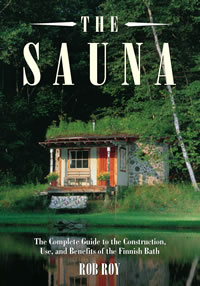 The Sauna, by Rob Roy, Chelsea Green Publishing, 2004, Paperback |
Earth Buildings
Buildings Made from Stone Buildings
Wood, Straw and
Bamboo Buildings
Solar Heated Buildings
Cabins,
Treehouses & Igloos
Ovens and Stoves
New Natural Building Books
- The Sauna: A Complete Guide to the Construction, Use, and Benefits of the Finnish Bath, by Rob Roy, Chelsea Green, 2004, Paperback
- Revised and expanded. Rob Roy shares his enthusiasm for the sauna and provides a complete, detailed guide to sauna building, along with resources for equipment and supplies. The Sauna is replete with history, tradition, health benefits, and instructions for proper use and maintenance, as well as step-by-step instructions for building a variety of cordwood masonry saunas and, new to this edition, conventionally framed saunas.
Natural Building Generally
- The Art of Natural Building: Design, Construction, Resources, edited by Kennedy, Joseph F; Smith, Michael and Wanek, Catherine, New Society Publishers, 2002, Paperback
- The ultimate ecological building resource includes examples of diverse natural dwellings, from a Hybrid Hobbit House to a thatched studio and a cob office. This volume is an encyclopedia of natural building for non-professionals as well as architects and designers. 100 illustrations & photos.
- Green Architecture, by Wines, James
Taschen, 2000, Paperback - When is a house ecological? Does the use of natural materials and solar cells on the roof make a building an example of "green" architecture? Perhaps even Antoni Gaudi and Frank Lloyd Wright designed "greener" buildings than most contemporary architects, whose low-energy houses scarcely differ outwardly from traditional ones. James Wines puts up the various -- and often irreconcilable -- concepts of environmentally-friendly architecture for discussion, making a case for an architecture that not only Focuses on technological solutions, but also tries to reconcile man and nature in its formal idiom. Among the examples of contemporary ecological architecture presented are works by Emilio Ambasz, Gustav Peichl, Arthur Quarmby, Jean Nouvel, Sim Van der Ryn, Jourda and Perraudin, Log ID, James Cutler, Stanley Saitowitz, Francois Roche, Nigel Coates and Michael Sorkin.
- How Buildings Learn: What Happens After They're Built, by Brand, Stewart
Penguin Books, 1995, Paperback - Like people, buildings change with age, forced to adapt to the needs of current occupations. This provocative examination of buildings that have adapted well, and some that haven't, calls for a dramatic rethinking in the way new buildings are designed, one that allows structures to grow and change easily with the environment. Photos.
- The Natural House: A Complete Guide to Healthy, Energy-Efficient, Environmental Homes, by Chiras, Daniel D, Chelsea Green Publishing Company, 2000, Paperback
- This exciting new book takes readers on a tour of 13 natural building methods, including straw bale, rammed earth, cordwood, adobe, earthbags, papercrete, Earthships, and more. Readers can learn how these homes are built, how much they cost, and the pros and cons of each. Includes a resource guide at the end of each chapter. Illustrations and photos.
- The New Natural House Book: Creating a Healthy, Harmonious, and Ecologically Sound Home, by Pearson, David, Fireside Books, 1998, Paperback
- With completely updated resource lists, dozens of new photos, and increased coverage on greenspace building, "The New Natural House Book" is destined to be even more successful than its bestselling predecessor. 144 color photos.
- New Organic Architecture: The Breaking Wave, by Pearson, David
University of California Press, 2001, Paperback - Architect David Pearson examines the tradition of curvilinear, asymmetrical architecture and gathers statements and examples of the work of contemporary architects from around the world that relate to forms in nature rather than to the stark geometry of the modern tradition in architecture.
 |
 Shelter, by Kahn, Lloyd, Shelter Publications, 2003, Paperback, $24.95 |
Vernacular Architecture
- Architecture Without Architects: A Short Introduction to Non-Pedigreed Architecture, by Rudofsky, Bernard, University of New Mexico Press, 1987, Paperback
- A unique examination of building and culture.
- Built by Hand, by Steen, Athena Swentzell , Steen, Bill , Komatsu, Eiko, Gibbs Smith, 2003, Hardcover
- This is the most extensive documentation ever published of traditional buildings throughout the world. With examples from every continent, it documents the diverse methods people have used to create shelter. 700 photos.
- Dwellings: The Vernacular House Worldwide, by Oliver, Paul, Phaidon Press, 2003, Hardcover
- A fascinating and informative document of the ways in which houses are constructed, decorated and inhabited around the world written by an internationally respected expert on vernacular architecture. Contains new field research and scholarship.
- Home Work: Handbuilt Shelter, by Kahn, Lloyd
Shelter Publications, 2004, Paperback - Building on the enormous success of his book "Shelter," Kahn continues his odyssey of finding and exploring the most magnificent and unusual hand-built houses in existence.
- Native American Architecture, by Nabokov, Peter , Easton, Robert ,
Oxford University Press, 1990, Paperback - Shelter, by Kahn, Lloyd
Shelter Publications, 2003, Paperback - First published in 1973, this classic counterculture book on organic design and architecture includes over 1,250 illustrations and a "Whole Earth Catalog"-type sourcebook for living in harmony with the earth by using every conceivable material. 66 color photos.
- Vernacular Architecture, by Glassie, Henry
Indiana University Press, 2000, Paperback - Drawing comparative examples from many locations in Europe and Asia, Glassie shows how architecture can be a prime resource for someone writing a democratic and comprehensive history.
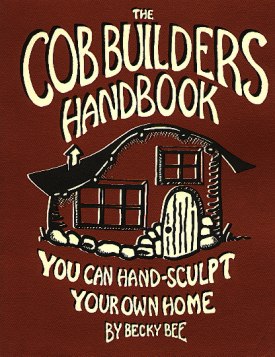 The Cob Builders Handbook by Becky Bee, Groundworks Publishing, 1998, Paperback, $23.95 |
Earth, Fired and Unfired
- Brick: A World History, by Campbell, James W P
Thames & Hudson, 2003, Hardcover - This is the first comprehesive work on brick, the essential building material, and ranges over every culture throughout history. It begins in 5000 BC and comes up to the 20th century. Indispensable to anyone practicing or studying architecture.
- Ceramic Houses and Earth Architecture: How to Build Your Own, by Khalili, Nader, Cal-Earth Press, 1999, Paperback
- Khalili's classic, authoritative manual describes how to build arches, domes, and vaults with earth, as well as techniques to fire and glaze earth buildings to transform them into ceramic houses. This newly revised edition also provides insight into the latest response by building officials to Superadobe or earthbag technology (structures of sandbags and barbed wire), a patented system that is free for the owner-builder and licensed for commercial use. Nader Khalili's ideas on ceramic houses and earth architecture have been published by NASA and utilized by the United Nations, and have passed building and safety tests in California. This new edition is now in its fifth printing.
- Clay and Cob Buildings, by McCann, John
Shire Books, 2004, Paperback - Buildings made of unfired earth are of great antiquity; in Britain they continued to be built until the middle of the nineteenth century. Consequently much of the traditional architecture that gives each region its distinctive character is of these materials. In this book John McCann describes the various processes of building with earth, quotes contemporary descriptions from past centuries, examines the regional patterns and illustrates standing buildings of clay and cob in many parts of Britain.
- The Cob Builders Handbook: You Can Hand-Sculpt Your Own Home, by Bee,
Becky
Groundworks Publishing, 1998, Paperback - One-third of the world's population lives in homes made of unbaked earth. Fifty thousand cob buildings are still in use in England today, most of them built in the 18th and 19th centuries. This is not a fad or craze, but rather a building technique that has stood the test of time. It is also, unfortunately, one of the many environmentally friendly techniques that was nearly lost in this century when we have been awash in a culture where every challenge is solved by the use of gallons of fossil fuel.
- The Hand-Sculpted House: A Practical and Philosophical Guide to Building a Cob Cottage, by Evans, Ianto, Chelsea Green Publishing Company, 2002, Paperback
- Building with earth is nothing new to America; the oldest structures on the continent were built with adobe bricks. Adobe, however, has been geographically limited to the Southwest. The limits of cob are defined only by the builder's imagination. Cob has been a traditional building process for millennia in Europe, even in rainy and windy climates like the British Isles, where many cob buildings still serve as family homes after hundreds of years. The technique is newly arrived to the Americas. Cob houses (or cottages, since they are almost always efficiently small by American construction standards) are not only compatible with their surroundings, they are their surroundings, literally rising up from the earth. They are full of light, energy-efficient, and cozy, with curved walls and built-in, whimsical touches.
- The Natural Plaster Book: Earth, Lime and Gypsum Plasters for Natural Homes, by Guelberth, Cedar Rose and Chiras, Dan , New Society Publishers, 2003, Paperback
- For builders of natural homes (straw bale, cob, adobe, rammed earth, and other natural materials), this unique step-by-step guide takes the confusion out of choosing, mixing, and applying natural plasters. 216 illustrations, some in color.
Stone
- Building with Stone, by McRaven, Charles
Storey Books, 1989, Paperback - An introduction to the art and craft of creating stone structures with step-by-step project instructions. Charles McRaven is a stonemason and blacksmith who is nationally known for building and repairing dozens of stone structures, log homes and post-and-beam buildings since 1946. He has restored water-powered mills, covered bridges, hewn log houses, and stone and timber-frame projects within the United States.
- Stone Circles: A Modern Builder's Guide to the Megalithic Revival,
by Roy, Rob
Chelsea Green Publishing Company, 1999, Paperback - Learn the technology of the ancients, and discover the living connection between humans and stones. Rob Roy began visiting stone circles as a young man wandering the moors of Great Britain. Keeping one foot in the rational and one in the transrational, he set out to build his own. This is the definitive guide to modern and not-so-modern techniques.
- Stone House: A Guide to Self-Building with Slipforms, by Stanley,
Tomm
Stonefield Publishing, 2004, Paperback - While providing a wealth of information on a range of relevant subjects, Tomm Stanley uses an instructional narrative to lead readers through the process of building with stone and slipforms. This is the first book dedicated to slipform stone masonry in many years. opics include: Traditional stonemasonry and slipforming; Basic geology and where to source suitable stone; Passive solar principles; Concrete making and techniques for molding and casting concrete; and methods for restoring recycled wooden windows and doors.
- Stone Work, by Jerome, John
University Press of New England, 1996, Paperback - From John Jerome, the critically acclaimed author of Staying With It, comes this story of a year he spent building a stone wall on his property in the Massachusetts Berkshires. A vision of extraordinary grace and beauty that will challenge readers to examine the possibilities inherent in stillness.
- The Stonebuilder's Primer: A Step-By-Step Guide for Owner-Builders
, by Long, Charles
Firefly Books Ltd, 1998, Paperback - The Stonebuilder's Prime, is a highly readable account of a couple's effort ot build "a house that will outlast anything made of wood." The author describes the complete building process in clear, easy-to-follow steps.
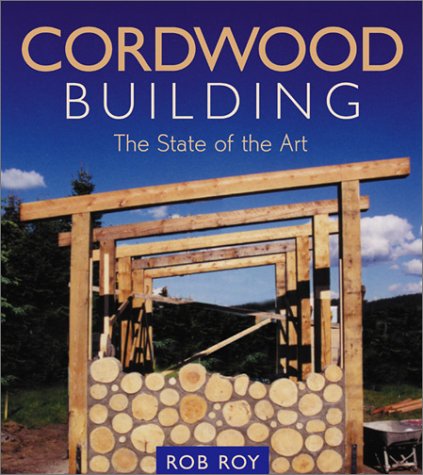 Cordwood Building, by Rob Roy, New Society Publishers, 2003, Paperback, $26.95 |
Wood, Straw and Bamboo
- The Beauty of Straw Bale Homes, by Steen, Athena Swentzell , and Steen, Bill, Treasure Chest Books, 2001, Paperback
- The authors, who also wrote "Straw Bale House", now have created a book that celebrates through color photographs the beauty of straw bale dwellings--from houses to larger institutional buildings. In an introductory essay, the Steens share the lessons they have learned from years of building with bales.
- Cordwood Building: The State of the Art, by Roy, Rob
New Society Publishers, 2003, Paperback - Cordwood masonry is an ancient building technique whereby walls are constructed from "log ends" laid transversely in the wall. It is easy, economical, aesthetically striking, energy-efficient, and environmentally sound. Cordwood Building collects the wisdom of more than 25 of the world's best practitioners, detailing the long history of the method, and demonstrating how to build a cordwood home using the latest and most up-to-date techniques, with a special focus on building code issues. Rob Roy has been building, researching, and teaching about cordwood masonry for 25 years and, with his wife, started Earthwood Building School in 1981. He has written 10 books on alternative building, and has taught cordwood masonry all over the world.
- Houses of Bark, by Shemie, Bonnie
Tundra Books, 1993, Paperback - A children's book describing the materials, construction, and uses of different kinds of shelters made by various Woodland Indians tribes in northeastern Canada and the United States.
- Grow Your Own House, by Velez, Simon
Vitra Design Museum, 2000, Paperback - Bamboo Architecture. .
- Habitat for Humanity How to Build a House, by Haun, Larry
Taunton Press, 2002, Paperback - From the world's leading authority on community home building comes a step-by-step guide to building an efficient, affordable, quality house. 350 color photos. 100 drawings.
- Serious Straw Bale: A Home Construction Guide for All Climates, by Lacinski, Paul , and Bergeron, Michel, Chelsea Green Publishing Company, 2000, Paperback
- This illustrated book is the first to closely examine the specific design considerations critical to success with straw bale building in more extreme climates. The authors draw upon years of experience with natural materials and experimental techniques to present a compelling rational for building with straw. 16-page color section.
- Straw Bale Building: How to Plan, Design, and Build with Straw, by Magwood, Chris , Mack, Peter, New Society Publishers, 2000, Paperback
- Two professional builders go through the process of building a bale structure, tackling all the practical issues—from how to find and choose bales to special concerns for northern climates. Architectural drawings & photos.
Solar
- The New Independent Home: People and Houses That Harvest the Sun, by Potts, Michael, Chelsea Green Publishing Company, 1999, Paperback
- Revised and expanded. Because of its impact in bringing the almost unknown promise of solar energy to thousands of readers, one longtime observer of energy trends described the publication of the original Independent Home as "the most important event in the solar industry in more than a decade".
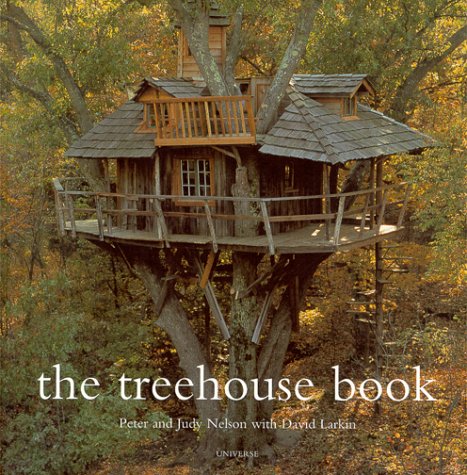 The Treehouse Book, by Pete Nelson, Rizzoli Publications, 2000, Paperback, $25.00 |
Cabins, Tree Houses and Igloos
- Building an Igloo, by Steltzer, Ulli
Henry Holt & Company, 1999, Paperback - A photo-essay picture book showing the traditional Inuit way of building a snow igloo.
- The Cabin: Inspiration for the Classic American Getaway, by Mulfinger, Dale, Taunton Press, 2001, Hardcover
- Proving less is more, this collection features an array of cabin design styles and materials--from sticks and stones to sheet metal and glass. Features designs and floor plans for 37 inspirational cabins from all across the country. 248 full-color photos. 50 illustrations.
- Hideaways: Cabins, Huts, and Tree House Escapes, by Faure, Sonya
Editions Flammarion, 2004, Hardcover - Shelters, Shacks & Shanties: And How to Build Them, by Beard, Daniel Carter , Foreword by Perrin, Noel, Lyons Press, 1999, Paperback
- Practical, lively instruction on building temporary structures is offered by one of the founding fathers of the Boy Scouts of America. Line drawings throughout.
- Shelters, Shacks and Shanties, by Beard, Daniel Carter
Breakout Productions, 1999, Paperback - Shelters, Shacks, and Shanties, by Beard, Daniel Carter , Foreword
by Kahn, Lloyd
Shelter Publications, 2003, Paperback - Written and illustrated in 1914 by one of the founders of the Boy Scouts of America, this primer contains detailed directions for constructing a wide range of shelters--including a complete log cabin. 338 illustrations.
- Shelters, Shacks, and Shanties: The Classic Guide to Building Wilderness Shelters, by Beard, Daniel Carter, Dover Publications, 2004, Paperback
- The Treehouse Book, by Nelson, Pete
Rizzoli Publications, 2000, Paperback - Detailed how-to information, such as step-by-step building sequences, plans, and drawings, as well as information on tools and materials, supplement the behind-the-scenes tales of treehouses. From casual tree shacks to multitiered flights of fancy, these magnificent structures can appeal to anyone appreciating this ever-evolving art form. Photos.
- Treehouses, by Pearson, David
Chelsea Green Publishing Company, 2001, Hardcover
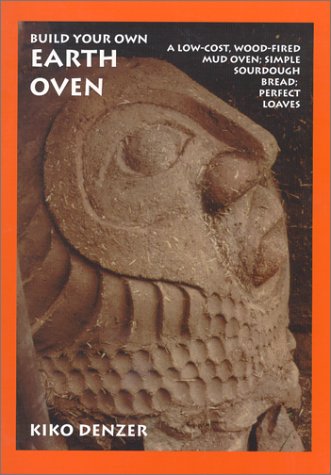 Build Your Own Earth Oven by Kiko Denzer, Hand Print Press, 2001, Paperback, $14.95 |
Ovens and Stoves
- The Bread Builders: Hearth Loaves and Masonry Ovens, by Wing, Daniel, Chelsea Green, 1999, Paperback
- Build Your Own Earth Oven: A Low-Cost Wood-Fired Mud Oven, by Denzer, Kiko, Hand Print Press, 2001, Paperback
- The Book of Masonry Stoves: Rediscovering an Old Way of Warming, by Lyle, David, Energy Shelter, 1997, Paperback
- The most comprehensive survey undertaken of the major types of masonry heating systems, ancient and modern. It shows the wide variety of possible sizes and shapes, from simple to elegant, from whimsical to gothic.
- Natural Home Heating: The Complete Guide to Renewable Energy Options,
by Pahl, Greg
Chelsea Green Publishing Company, 2003, Paperback
 You Can Make the Best Hot Tub Ever! by Becky Bee, Groundworks Publishing, 2001, Paperback, $14.95 |
Saunas and Hot Tubs
- You Can Make the Best Hot Tub Ever!: Relax! Warm Your Bones! Get to Know the Sky!, by Bee, Becky , Groundworks Publishing, 2001, Paperback
- The Sauna: A Complete Guide to the Construction, Use, and Benefits of the Finnish Bath, by Rob Roy, Chelsea Green Publishing Company, November 2004, Paperback
- Revised and expanded. Rob Roy shares his enthusiasm for the sauna and provides a complete, detailed guide to sauna building, along with resources for equipment and supplies. The Sauna is replete with history, tradition, health benefits, and instructions for proper use and maintenance, as well as step-by-step instructions for building a variety of cordwood masonry saunas and, new to this edition, conventionally framed saunas.
Toilet Systems
- The Humanure Handbook: A Guide to Composting Human Manure, by Jenkins,
Joseph
Jenkins Publishing, 2005, Paperback - Tenth Anniversary Edition. There are almost seven billion defecating people on planet Earth, but few who have any clue about how to constructively handle the burgeoning mountain of human crap. "The Humanure Handbook," third edition, will amuse you, educate you, and possibly offend you, but it will certainly pertain to you, unless, of course, your bowels never move. "One of the most serious and humorous, well-researched yet humble, and motivating works I have read in a while."—from the cover. Illustrated. 259 pages.
- The Toilet Papers: Recycling Waste and Conserving Water by Sym Van der Ryn
Ecological Design Press, 2000, Paperback - A classic is back in print! One of the favorite books of 1970s back-to-the-landers, The Toilet Papers is an informative, inspiring, and irreverent look at how people have dealt with their wastes through the centuries. In a historical survey , Van der Ryn provides the basic facts concerning human wastes, and describes safe designs for toilets that reduce water consumption and avert the necessity for expensive and unreliable treatment systems. The Toilet Papers provides do-it-yourself plans for a basic compost privy and a variety of graywater systems.
- The Home Water Supply: How to Find, Filter, Store, and Conserve It,
by Campbell, Stu
Garden Way Pub. Co., 1983, Paperback - Knowledgeable discussion of home water systems, potential water problems, and practical, money-saving solutions.
- Lifting the Lid: An Ecological Approach to Toilet Systems, by Harper,
Peter and Halestrap, Louise
Centre for Alternative Technology, 2001, Paperback - The Septic System Owner's Manual, by Kahn, Lloyd, and Allen, Blair
Shelter Publications, 2003, Paperback - For the rural homeowner, this illustrated, easy-to-understand manual covers the basics of a septic tank and drain field, potential problems and solutions, greywater systems, composting toilets, and other alternatives. 125 illustrations. Tables.
Why Build?
- A Hut of One's Own: Life Outside the Circle of Architecture, by Cline,
Ann
MIT Press, 1998, Paperback - An exploration of the smallest and simplest of dwellings offers answers to some of the largest and oldest questions about architecture. Cline blends autobiography, historical research, and cultural criticism in an original and imaginative attempt to rethink architecture by studying its boundary conditions and formative structures. 61 illustrations.
- A Place of My Own: The Education of an Amateur Builder, by Pollan,
Michael
Delta Trade Paperbacks, 1998, Paperback - At a critical time in his life, Michael Pollan, the author of the award-winning Second Nature: A Gardener's Education, decided he wanted to build a small wooden hut in the woods near his Connecticut home. This absorbing narrative recounts Pollan's construction project, taking readers on a tour of the centuries of wisdom and philosophy that inform the buildings in which we live.
- The Place of Houses, by Moore, Charles Willard
University of California Press, 2001, Paperback - This is a book for people interested in domestic architecture who might wish to build a house of their own, with both philosophical questions and pragmatic matters to be considered as the reader thinks about what is wanted in a house, what needs and desires one wishes it to serve.